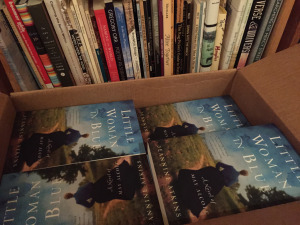Moving Between Poetry and Fiction and Back Again
In my last blog, I wrote about my path from writing for children to writing a novel for adults. I also shift between writing prose and poetry. I am not a brander’s dream. But most of us read a variety of poetry, novels, and nonfiction – exquisite and trashy — so why not write in all forms? Yeah, there’s that issue of time (speaking of which, where did September go?) I’m not talking about writing quickly: that’s not in my repertoire. But I find myself sometimes craving the deepening that poetry requires, and sometimes want to sprawl into the width a life demands. And I’m not sure there’s as much difference as Samuel Coleridge suggested when he called prose words in their best order, and poetry the best words in the best order.
In the past I turned a novel to narrative verse and have known others who’ve done that, too, or the other way around. You can learn a lot by crossing genres. But May Alcott, the youngest artistic sister of the writer Louisa, never seemed a subject for verse of any kind. I wrote my debut novel for adults, Little Women in Blue: A Novel of May Alcott, as prose because these sisters wanted to talk. May was a painter who loved and was inspired by nature, always good topics for verse, but I wanted the context of the long curve of her dream to have a life that included both art and love. The conflicts that arose from that desire and all its obstacles demanded some bulk.
Fiction offers a bigger room, though I remain fussy about every word, and the rhythm and syntax of sentences. The poet can’t entirely disappear. My writing group pointed out scenes that repeated themes and didn’t add much to characterization. These had to go. Housework was a huge part of May’s daily life, but there are only so many times someone wants to read about doing the dishes and washing windows. I cut some accounts. Drafting a novel is like crafting a long branch I’ll need to lop off near the trunk; most leaves can be raked to the side, but I might pick up one or two.
Writing Little Women in Blue took a long time and a lot of research, let’s say around fifteen years. I loved most of that reading and the dwelling necessary to turn the facts to fiction. Between drafts I worked on other manuscripts, sometimes working in verse, taking a well-lived life down to its beautiful bones. I was particularly inspired by the way Marilyn Nelson brought alive the scientist in Carver: A Life in Poems and Karen Hesse’s beautiful, spare novels. Somewhere between drafts of my novel about May, I wrote nonfiction about Laura Ingalls Wilder, Madam C.J. Walker, and Marie Curie, which I eventually turned into verse for Borrowed Names. The nonfiction had kept me to the biographical high points, while I wanted some of what’s common, coming from inference and imagination, which poetry allows, to connect the famous person to readers.
And now? I’m working on a novel, reading slim volumes of poems every chance I get, and standing by with broom and dustpan for when copy edits return for Finding Wonders: A Verse History of Girls and Science, coming from Atheneum next year. I’m also doing what a writer must do between finishing a novel and seeing that it finds places in the hands of readers who like history and women who didn’t get their fair place in it, readers who loved Little Women and also those who did not.
Chances to win a copy of Little Woman in Blue are being offered this week at Under my Apple Tree or at Broken Teepee.
For the Poetry Friday roundup, please visit the insightful and generous folks at Poetry for Children.






